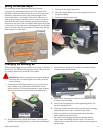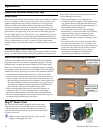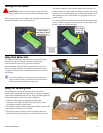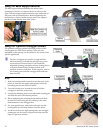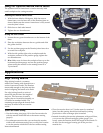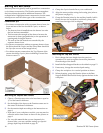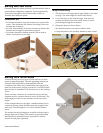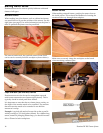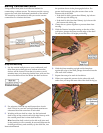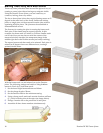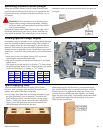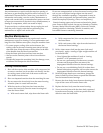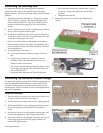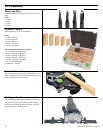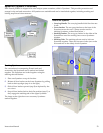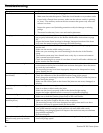
20 Domino DF 500 Tenon Joiner
Maintenance
Any maintenance or repair work that requires opening of
the motor or gear housing should be carried out only by an
authorized Customer Service Center (see your dealer for
information on locating a service center). Maintenance or
repair work carried out by an unauthorized person can lead
to improper connection of electrical wires, misadjustment, or
damage to components, which can result in injury.
To prevent injury or electrocution, always unplug the tool
from the power supply outlet before performing any
maintenance or repair work on the tool!
Do not use compressed air to clean the motor housing of the
tool, as you could inject foreign objects into the motor
through the ventilation openings. Compressed air may be
used on other components, but personal safety protection
should be employed (hearing, vision, and respiratory).
Certain cleaning agents and solvents are harmful to plastic
parts. Some of these include, but are not limited to: Gasoline,
Acetone, Methyl Ethyl Ketone (MEK), Carbonyl Chloride,
cleaning solutions containing Chlorine, Ammonia, and
household cleaners containing Ammonia.
Routine Maintenance
The Domino tenon joiner does not require much routine
maintenance except for cleaning. For best performance and
long life of the Domino tenon joiner, keep the machine clean.
► To ensure proper cooling of the tool and motor, the
cooling vents in the motor housing must always be kept
clear and clean. Keep the motor cooling inlets at the back
of the handle clean and free from sawdust.
► Keep the linear rails clean and free from sawdust.
► Always use the Domino joiner with a dust collection
system.
► Periodically inspect the mortising bit(s) for damage, wear,
or dullness. Re-sharpen the bits as necessary.
Cleaning and Maintenance
1. Blow off the exterior of the machine with compressed air
to remove sawdust, but do not blow air directly into the
air cooling vents on the back of the motor as this can
drive debris into the motor.
2. Blow out impacted sawdust from the mortising bit area.
3. Do not remove the fence body from the motor housing
when the joiner is coated with sawdust.
4. With the exterior of the joiner free from sawdust,
remove the fence body from the motor housing and
clean the linear slides:
a. With a soft cotton cloth, wipe down the linear rails.
b. With compressed air, blow out any dust from inside
the linear bores.
c. With a soft cotton cloth, wipe down the interior of
the bronze linear bearings.
5. With a clean cotton cloth (not the same cloth used
previously), apply a coating of light-weight machine oil
to the linear rails.
► Use a lightweight machine oil such as “sewing
machine” oil or pneumatic tool oil.
► Do not use a penetrating oil as these may contain
solvents and detergents that can remove the
impregnated lubricant from the bronze bearings.
► Do not use a rust inhibiting fluid/oil as these have
limited lubrication properties, and can also remove the
impregnated lubricant from the bronze bearings.
6. With the plunge depth set to maximum, plunge the
joiner in and out several times to spread the lubricant
into the internal bronze bearings.
7. Remove the fence body from the motor housing and
wipe off the excess oil from the linear rails.
8. Replace the fence body onto the motor housing.
9. Never store the joiner with the fence body separated
from the motor housing, as this can permit dust and
debris to enter the linear slide.



